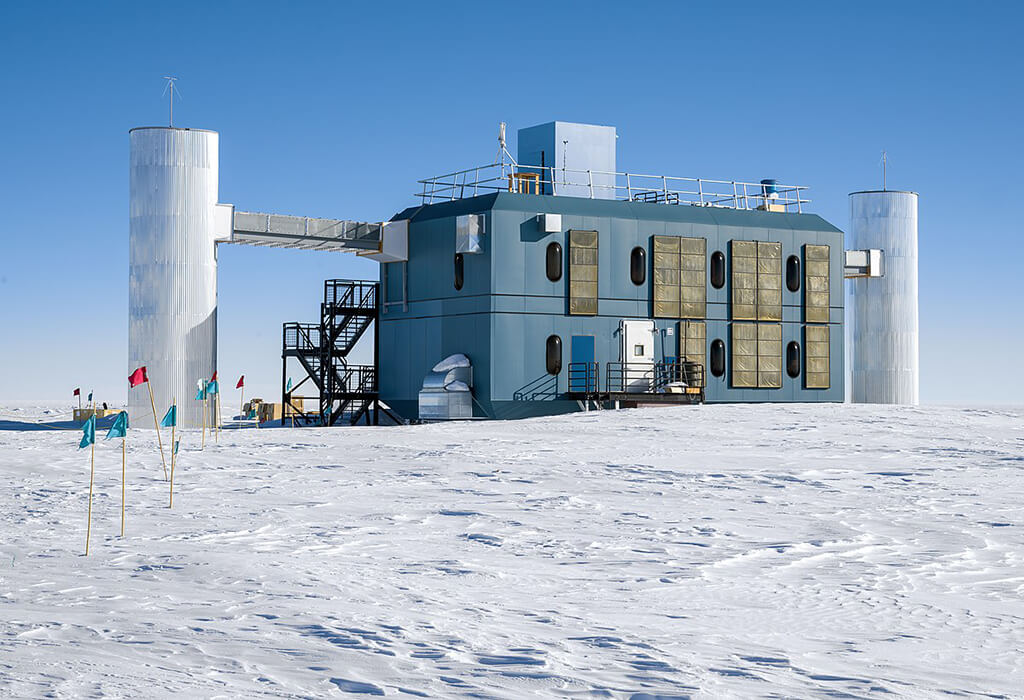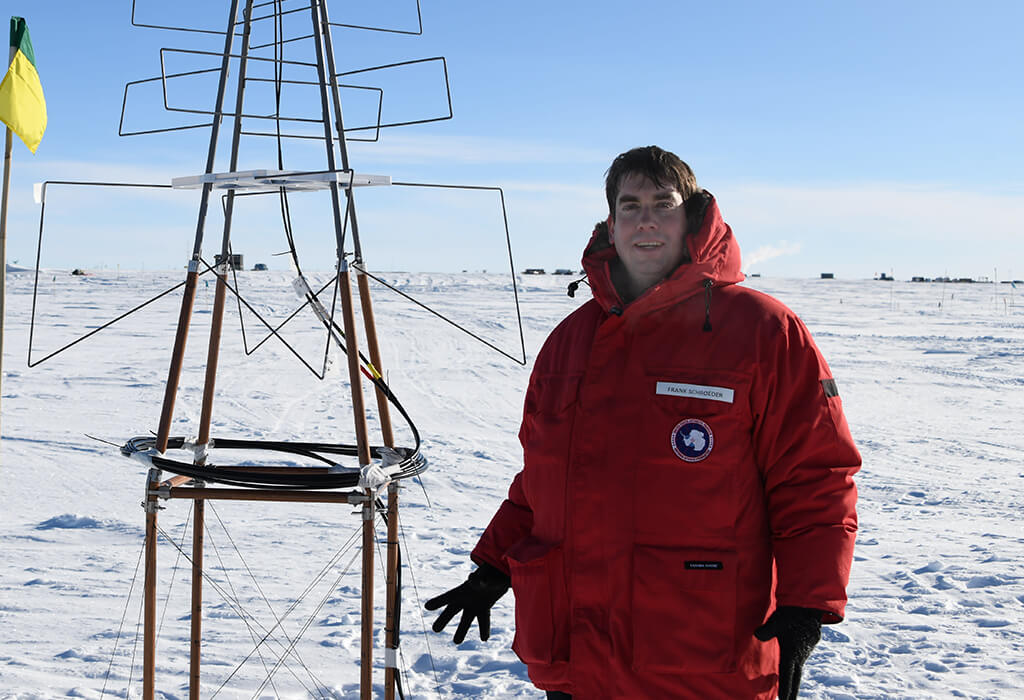Enhancing the surface detector of the IceCube Neutrino Observatory at the South Pole


IceCube Neutrino Observatory.
Prof. Dr. Frank Schröder is an Associate Professor at the University of Delaware in the USA, and a Group Leader in astroparticle physics at the Karlsruhe Institute of Technology in Germany.
He told us about the collaboration with CEMTL which saw them installing specially modified antennas at the IceCube Neutrino Observatory at the South Pole in a prototype setup preparing to greatly enhance the existing detectors and gain reliably accurate data – despite the challenges of freezing temperatures, never-ending snow drifts, and Covid-19 lockdown restrictions.
Timeframe: The project began February 2019 and will be completed January 2025, with the antennas remaining in place and delivering data for many years to come.
Summary of the project
Funded by a European Research Council (ERC) grant – Digital Radio Detectors for Galactic Peta-electron Volt Particles (PEV Radio) – the goal was to enhance the surface detector of the IceCube Neutrino Observatory at the South Pole by installing radio antennas. This would increase the accuracy of measurements.
The IceCube Neutrino Observatory’s main purpose is to detect neutrinos; elusive particles from space. It also studies cosmic rays from high-energy particles from space, measured at the surface of the South Pole through particle detectors already in place.
Through a simulation study to explore which radio frequency band would be best, Frank and colleagues discovered that it fell into the band also used by the Square Kilometre Array (SKA), where Eloy from CEMTL is the antenna developer.
But these were not designed for the extreme weather conditions at the South Pole, so prototypes were placed there first to verify that everything worked correctly.
The challenge. How to you ensure antennas work at the South Pole?
“We had to modify things!” explains Frank. “The antenna itself is the same, but we had to ensure the surroundings were up to the challenge of these extreme conditions.”
Firstly, they put the antennas on elevated poles. The wind continually blows in snow at the South Pole and they don’t want them to be buried. So they were put on poles so that every few years we can just extend the poles and move the antenna upwards.
And secondly, they used their own data acquisition with a higher dynamic range to read out the radio signals, which worked well combined with these antennas.
“I went to the South Pole for about three weeks in January 2020 for the installation – shovelling snow myself along with 3 other members of the team. I was very glad to be able to buy these antennas from CEMTL instead of needing to develop my own – not only did it save time but I could also trust the quality.”
What were the benefits of this technology?
There two properties which are particularly valuable, explains Frank:
- They have wide sky coverage. Many antennas are beamed in a particular direction, but we wanted to have much wider coverage.
- They also come with a preamplifier which does all the amplification we need. In previous projects I always needed two stages; a preamplifier and the main amplifier. With CEMTL’s antennas we just need the one pre-amplifier in the antenna and don’t need any second amplifier afterwards.
There is also the lasting impact, which makes it such a valuable use of the ERC funding.
The antennas will remain there, that’s one result of our successful prototype station. We actually expect that in some years from now we can do a large extension of the Ice Cube Neutrino Observatory, called IceCube-Gen2, which will include these antennas at the surface.
So it could be the start of a project that will last for two, maybe three decades.
How did the global pandemic affect the progress of the project?
We had the prototype station, featuring three antennas in total. And PhD students would go to the South Pole to do modifications and updates and continue with the full installation of the array.
Unfortunately, this work was disturbed due to the covid-19 lockdowns. The National Science Foundation in the US – who operate the South Pole station – had to restrict activity to allow only very essential maintenance.
The strict measures put in place at the South Pole resulted in a backlog of infrastructure and research projects, and we’re still catching up with the installation of further antennas.
The IceCube Neutrino Observatory was able to continue data taking and transmit data to the north via satellite so we could continue to analyse the data. But they were not able to permit any additional installations, because the amount of people allowed to work at the South Pole was very restricted.
What’s different about this antenna technology?
It’s the sum of several smaller things which just make this antenna a very good antenna.
You want to record high quality data in the beginning. You want to have a good signal to noise ratio. We know that the amplitude of the radio signal we measure really is the amplitude of the true radio signal coming from our cosmic rays.
So all of the developments CEMTL have done to prepare the antenna for the Square Kilometre Array come together to make better measurements.
We decided to buy this one instead of cheaper, more simple antennas – which may somewhat degrade the quality of our measurements.
Because if you go to a place like the South Pole where you have to factor in the logistical challenge of getting there and installing the antenna, you want to ensure that the equipment is of the highest possible quality.
What are the benefits of using this antenna technology?
The radio technique is now used in a variety of projects for ultra-high energy cosmic rays. So at least half of the projects targeting the science field of cosmic particles at the highest energies use radio antennas for at least some purposes, some as standalone techniques, some as complementary technique to increase accuracy.
And a particular benefit of the frequency band we use with CEMTL’s antennas is that we are able to lower the detection threshold. We can cover a wider energy range of cosmic rays than we would be able to with frequency bands used in prior radio experiments.
What’s so critical about this particular technology?
So the main reasoning behind getting the ERC funding was the opportunity to use a specific frequency band to enhance the energy range for cosmic particles.
After we did simulations to optimise the frequency band, there was little doubt that it really makes a major difference what band you used…but nobody had really thought before that it could have such a large impact when it was changed.
I would say it has made an order of magnitude difference. So, in physics, we often call things order of magnitude if they are roughly a factor of ten, for example.
So, compared to a frequency band which is not optimized for the science case of radio detection of cosmic rays, using the optimum frequency band covered by these radio antennas can lower your energy threshold by an order of magnitude. And consequently increase your energy range also by an order of magnitude for cosmic rays.
What was the impact of the project?
The question I’m seeking to answer in my academic research is what’s the origin of the most energetic particles we have in our galaxy?
Having a higher accuracy of cosmic ray measurements helps us to target that question.
Due to the Covid delays, we have not been able to construct the full array until now. But we have demonstrated that the idea of lowering the threshold really works in practice.
